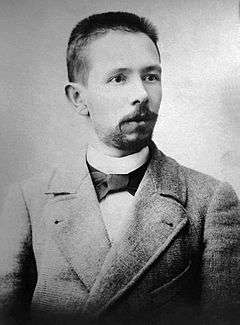Symphony No. 1 (Kalinnikov)
The Symphony No. 1 in G minor by Russian composer Vasily Kalinnikov was written from 1894 to 1895 and first published in 1900. The symphony is dedicated to Russian music critic and teacher Semyon Kruglikov.[1]
| Symphony No. 1 | |
|---|---|
| by Vasily Kalinnikov | |
 The composer on a postcard from the 1910s | |
| Key | G minor |
| Composed | 1894–95 |
| Dedication | Semyon Kruglikov |
| Published | 1900 |
| Movements | 4 |
| Premiere | |
| Date | 1897 |
| Location | Kiev |
History
Background
After contracting tuberculosis in 1893 while serving as conductor of the Maly Theatre in Moscow, Kalinnikov moved to Yalta[2] for a more salubrious climate. It was there that he composed his first symphony. Upon completion in 1895, the symphony’s score was sent to its dedicatee Kruglikov, who was both Kalinnikov's teacher and financial benefactor. Kruglikov recommended the work to the country's leading conductors.[3]
Premiere
The symphony was premiered in 1897 at the Russian Music Society in Kiev. It was conducted by Alexsandr Vinogradsky and was received well by the audience, who gave the second and third movements an encore.[3] The success of the premiere was followed by performances in Vienna, Paris, London, and Berlin.[2]
Form
The symphony is in four movements:
- Allegro moderato (G minor)
- Andante commodamente (E-flat major)
- Scherzo: Allegro non troppo (C major)
- Finale: Allegro moderato (G major)
The first movement is in sonata form and opens with the main theme played in unison strings. The second theme is also presented by the strings, with woodwinds in the background. The development section is contrapuntal in nature, reminiscent of the fugues Kalinnikov composed in the 1880s. The second movement opens with an ostinato of the harp and first violins that leads into a solo for the cor anglais. Then the movement's main theme is played by the oboe to pizzicato strings. The third movement, a scherzo, contains Russian folk-music influences and melodies and includes a trio played in the woodwinds. The Finale opens with the first movement's main theme before revisiting and transforming themes from all previous movements as well as incorporating new themes derived from old ones. The symphony concludes with a triumphal ending played by the full orchestra.[2][4][5] A typical performance lasts around 40 minutes.
Recordings
The following is a list of notable recordings of the work, listing year, orchestra, and conductor:[6]
- 1941: Indianapolis Symphony Orchestra, Fabien Sevitzky
- 1951: Czech Philharmonic, Hermann Scherchen
- 1975: USSR State Symphony Orchestra, Evgeny Svetlanov
- 1987: Royal Scottish National Orchestra, Neeme Järvi
- 1993 (Finale only): United States Marine Band, Timothy Foley
See also
References
- "Symphony No.1 in G minor (Kalinnikov, Vasily)". International Music Score Library Project. Retrieved September 26, 2019.
- Morrison, Chris. "Vasily Kalinnikov Symphony No. 1 in G minor". AllMusic. Retrieved September 26, 2019.
- Mathias, Shari. "Vasily Kalinnikov – Russian Master, Gone Too Soon". Parker Symphony Orchestra. Retrieved September 26, 2019.
- Blumhofer, Jonathan (March 17, 2018). "Rethinking the Repertoire #20 – Vasily Kalinnikov's Symphony no. 1". The Arts Fuse. Retrieved September 26, 2019.
- "Vasily Kalinnikov: Symphony no. 1 in G minor". Fugue for Thought. November 12, 2015. Retrieved September 26, 2019.
- "HenrysRecords.org Search Results". HenrysRecords.org. Retrieved November 5, 2019.
External links
- Symphony No.1 in G minor (Kalinnikov, Vasily): Scores at the International Music Score Library Project (IMSLP)